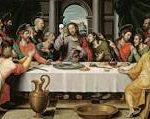Faith Sizes
A sermon preached at the Church if the Incarnation, San Francisco, on March 12, 2017, by Christopher L. Webber.
There’s a little poem I saw somewhere years ago that says this:
Men’s faces, voices differ much,
Saints are not all one size.
Flowers in a garden various grow;
Let none monopolize.
(Morgan Lywd, 1619-1659)
“Saints are not all one size.” Relationships with God come in all shapes and sizes. I think that’s good news and bad. It’s bad news because we like to have simple answers and standard sizes. I remember looking for socks one day and finding some marked: Sizes 6-12. One size fits all – or almost all. How do they do that? I don’t know, but it works. Christian faith is not like that. “Saints are not all one size.” But that’s good news because I think it helps to know that not all Christians are the same size. In other  words, I can’t expect to be the same kind of Christian as St. Paul or St. Francis or Joan of Arc or even as another member of this congregation. So that’s good news: I don’t necessarily have to write epistles or preach to the birds or lead armies or even necessarily help out in a soup kitchen. Some saints will do that and some won’t and that’s fine. But that’s also bad news because our relationship with God is so important, so life-changing, that we can’t help wanting a prescription to follow and to be able to analyze everyone else by the pattern that works for me.
words, I can’t expect to be the same kind of Christian as St. Paul or St. Francis or Joan of Arc or even as another member of this congregation. So that’s good news: I don’t necessarily have to write epistles or preach to the birds or lead armies or even necessarily help out in a soup kitchen. Some saints will do that and some won’t and that’s fine. But that’s also bad news because our relationship with God is so important, so life-changing, that we can’t help wanting a prescription to follow and to be able to analyze everyone else by the pattern that works for me.
Maybe it’s partly the way things are in an industrial society. You remember how Henry Ford said you could have a car in any color you wanted as long as it was black. So you can get any pack of beer you want as long as it’s a six pack. You probably won’t find a seven pack or a five pack. We live in a standardized world. There is, however, a book called, “How to wrap five eggs” published in Japan in the 1970s that explains how things used to be done in a less standardized world. But they haven’t read it at Safeway. And you can get a huge argument over public schools and charter schools that is basically on that subject. We obsess about every child reading at a certain level by a certain age. But maybe some aren’t ready. Children are not all one size. That doesn’t mean I necessarily agree with Betsy DeVos. It’s a lot more complicated than that.
Some churches have a check off system: attends every Sunday, pledges 10%, joined a Bible study group, etc. to see who measures up. And that’s all great but take that same trio I started with: Sts. Paul and Francis and Joan of Arc and ask what they had in common or even whether they pledged and went to Bible study and I don’t see a standard pattern.
It’s hard to avoid thinking that if others see God through different eyes and respond to God in different ways, there’s something wrong with them. They must be deprived or depraved, or unhappy or heretical. I mean, if my congregation, my church, the Book of Common Prayer and the Anglican form of Christianity have been the means by which I have come to know God’s love, it’s hard to understand why someone else would want to be a Methodist or Congregationalist or Roman Catholic. In fact, we ought to want others to know God’s love as deeply as we do and more deeply. I want that for you. But it doesn’t necessarily mean that God’s plan for you is the same as God’s plan for me. It doesn’t mean I should be working to get all of you off to seminary and ordained. This congregation doesn’t need a lot more Episcopal priests. One or two is more than enough. What it needs is maybe one of those and some Vestry members and a treasurer and clerk and an organist and sexton and someone to set up the coffee hour and someone to pitch in at the book sale and lots of people to pray for everything that needs prayer. We don’t need fifty sopranos; or fifty quilters. We need thirty or forty or fifty or more individuals, all different, each responding to God in a different way and each playing a different part in God’s church and God’s world. I think very often we are like the infant who has just discovered the joys of pablum and offers others at the table a taste from her spoon. Pablum is wonderful stuff, but most of us have moved on. Some of us have moved on to broccoli and others to spinach; tastes differ. We all need vitamins and minerals but we don’t all need to get them in the same form.
Episcopalians have often said that our goal is “unity in essentials and diversity in non-essentials and charity in all things.” But what’s essential and what’s non-essential? That question is being asked these days with new intensity. What is it that we have to agree on in order to live together in one church? What is it we have to agree on to live together in one country?
I raise these questions because this is Abraham Sunday. Always on the Second Sunday in Lent we hear about Abraham. Abraham followed God’s call and came into the promised land. And here we are:  Abraham’s descendants. What do we have in common? What do we need to have in common? What is essential to serving God and following God as Abraham did? Abraham is sometimes called “our father in faith;” the first to respond to God in faith. What do we need to do to be his descendants: children of Abraham?
Abraham’s descendants. What do we have in common? What do we need to have in common? What is essential to serving God and following God as Abraham did? Abraham is sometimes called “our father in faith;” the first to respond to God in faith. What do we need to do to be his descendants: children of Abraham?
When we look at the readings this morning they show us drastically different ways of response to God. So let’s start there: what is there in these readings for us to learn? The Old Testament passage is amazingly brief and shows us God giving Abraham a command and promising Abraham blessings. But all God asks of Abraham is obedience. God said, “Go,” and Abraham went. And that’s pretty much how it was for Abraham. God spoke and Abraham jumped.
“Get out of here and go west.”
“OK, Lord; I’m going.”
:Sacrifice your son on an altar.”
“Right, Lord, I’m on my way.”
Abraham was obedient. That’s one pattern of response and for some people it’s an easy and natural response: just tell me what to do. It worked for Abraham; maybe it’ll work for you. But, you know, it won’t work for me or for most Episcopalians. We always want to know why.
I remember trying to get that across to a former Roman Catholic priest years ago who was on his way into the Episcopal Church. He was coming into a church that provides a lot of freedom, and I kept having to say, “John, when an Episcopal bishop asks you to jump, your response isn’t, ‘How high?’ but ‘Why?’”
Abraham wasn’t an Episcopalian; he didn’t ask; he just did it. Leave home and family, OK. Sacrifice your son, OK. God tells me what to do and I do it. That was Abraham’s way and that’s still the pattern in some churches. Here are the rules; don’t ask. But what a contrast with today’s Gospel. Here’s poor Nicodemus trying to figure it out, trying desperately to understand what Jesus is talking about. Nicodemus had questions and he wanted answers. t’s hard to imagine a sharper contrast with Abraham. But some people are like Nicodemus and need to ask questions, need to explore different answers. I think that’s more comfortable for Episcopalians than Christians in some of the narrower traditions. We want reasons. We want to understand. We’re more like Nicodemus than Abraham. I remember coming by a church once that had signs out front saying: “You have questions; We have answers.” But there’s an Episcopal Church I know of that gives its members bumper stickers saying: “Thoughts provoked daily.” Not answers provided, but thoughts provoked, questions raised.
So there are at least two patterns, two ways of being a Christian, and the epistle leads us in still a third direction by stressing faith and picturing Abraham not so much as a man of obedience but as a man of faith. The problem is that we don’t really see that in the Biblical picture of Abraham; what we see is what he did. And I think we need to pay attention to that.
I think most Christians have trouble with the idea of faith because it’s so invisible, so unmeasurable, and it seems to ask us to see what can’t be seen and measure what can’t be measured. How do we know faith? How can we be sure? And of course, that’s a paradox, maybe an oxymoron. We’ve been brainwashed by science into thinking we have to be able to use the same techniques scientists use to prove faith, demonstrate faith the way you can prove that water freezes at 32 degrees. But you can’t. If you can measure it or know it or be sure of it, it isn’t faith; it’s something else.
Abraham was told to go and he went. On the surface, at least, that’s obedience, not faith, but it is the evidence of faith. And I think that’s what we ought to look for. If we have to look for faith, let’s look for what we can see. Now, that gets us into potential trouble because it seems to be saying that works is what matters. It isn’t. That’s not what I’m saying. But what I am suggesting is that most of the time it’s the only part of faith you can see. It’s all we can see of Abraham’s faith. It’s all we can see of Paul’s faith or Augustine’s faith and probably all we can see of our own. We can see what we do, not what we believe. And what I’m suggesting is that we need to concentrate not on what we can’t see but on what we can. And we can take these two contrasting pictures – Abraham and Nicodemus as two pictures of faith in action. God told Abraham to go and he went. That’s faith in action. Nicodemus came to Jesus with questions and that’s faith in action also. It’s faith that cares enough to ask question. Faith that takes the time to come and discuss and try to understand. I would even go so far as to say that we shouldn’t worry about faith, not think about it, not concern ourselves about it. Yes, I know, we are saved by faith, faith alone, but somehow the more we worry about it, the less we have it. The more we aim at it, the more we are likely to miss it.
I came across some words of Rabbi Abraham Heschel that I think throw a useful light on the subject: He said, “The secret of spiritual living is the power to praise. Praise is the harvest of love. Praise precedes faith. First we sing, then we believe. The fundamental issue is not faith but sensitivity and praise, being ready for faith.”
Notice the hierarchy: “Praise is the harvest of love. First we sing, then we believe.” In other words, love produces praise and praise leads to faith. First we sing, then we believe. It sounds counter-intuitive, but isn’t that what St. Paul is saying in that great 13th chapter of First Corinthians when he says: “There are three things that matter: faith, hope, and love; but the greatest of these is love.” That’s Paul, remember; Paul the great advocate of faith. Paul says love, not faith, is greatest.
Would it fit with your experience, I wonder, to suggest that love leads to praise and praise leads to faith? that love is greatest because love is the foundation, that love is greatest because love is the end, that love  is the beginning and end, and that we are saved by faith through grace because faith is the name of the critically essential response we make to that love that surrounds us and draws us ever onward and upward?
is the beginning and end, and that we are saved by faith through grace because faith is the name of the critically essential response we make to that love that surrounds us and draws us ever onward and upward?
Abraham is one role model; there are many. “Faith,” the Epistle to the Hebrews says, “is the evidence of things not seen.” And it goes on to cite the various scriptural figures who responded to God in various ways, by making an offering, building an ark, saving a baby, abandoning Egypt, by being stoned to death, sawn in two, killed by the sword; suffering destitution, persecution, torment. Those acts are not faith themselves but they are the visible evidence of invisible faith.
I knew a senior warden once who would come into my office at regular intervals to worry about a particular phrase of the Creed that he wasn’t sure he believed. And I used to say, “Stop worrying. You’re in church every Sunday, you serve on the Vestry, you contribute your time and talent to every good cause that comes along, and you take the Creed seriously, and you care enough to ask good questions. If that’s not faith, I don’t know what is.”
Saints are not all one size. So look for examples and learn from them, but don’t feel you need to be like any one of them. Be who God is calling you to be, now, where you are; respond in love, respond with praise, care enough to ask questions, and the evidence of your faith will be there.
 Christopher L. Webber
Christopher L. Webber
This is so good Chris. Great themes and life stories deftly illustrating the wind blows where it chooses.
Thanks! Best wishes.